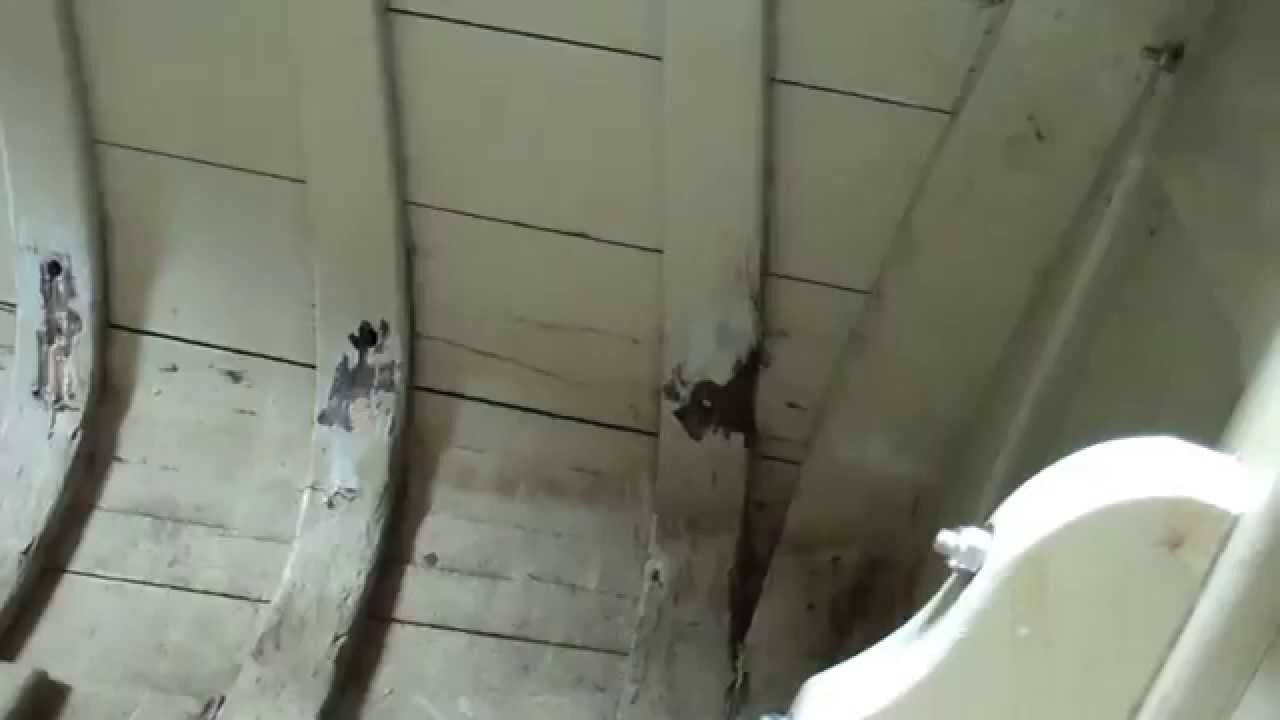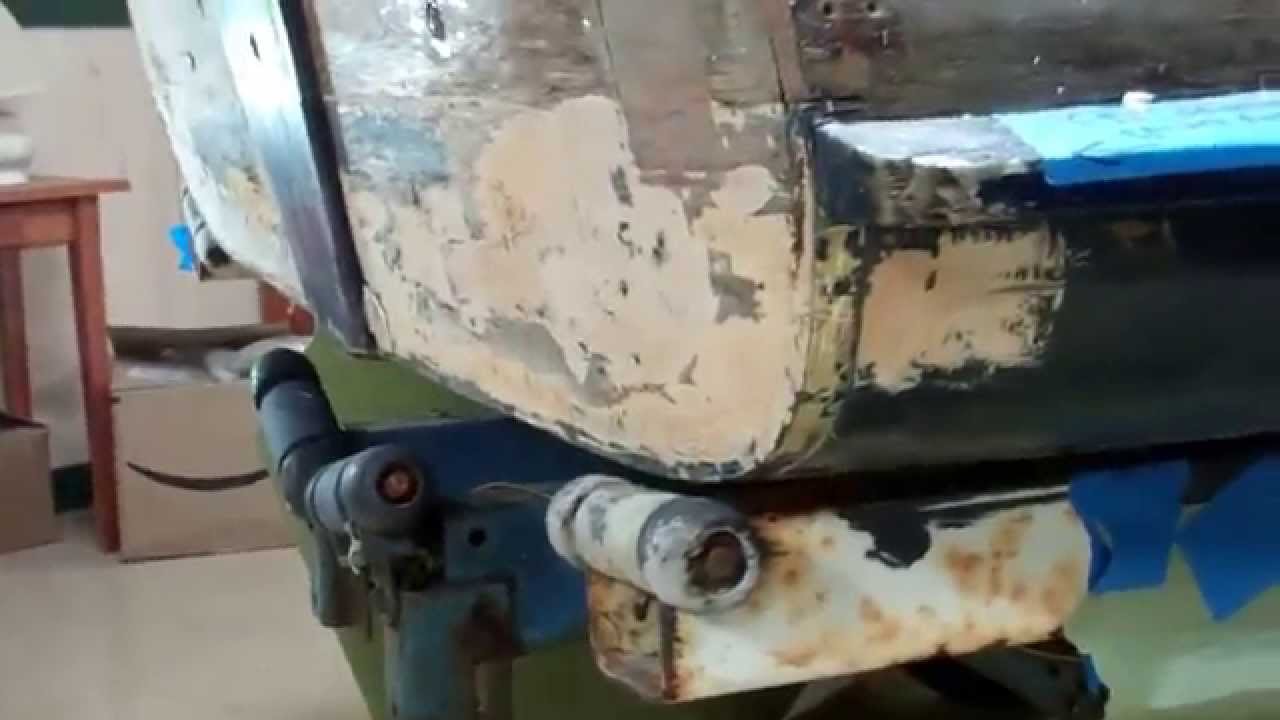DeWe flipped the Captivator, fully intending to extract all of the residual black walnut stain from the topsides using Circa 1850 paint and varnish remover. But I decided to test removing the bottom paint, first with a heat gun and scraper, and when that failed, grabbed our infrared Silent Stripper.
The entire bottom had been glazed with the same wood filler we have already encountered elsewhere. In some places the “glaze” was as much as 3/16” deep. The heat gun softened the paint, but scraping it off the filler proved impossible.
Even though its operating range is 300-500 degree Fahrenheit, the filler began vaporizing and smoking, and quickly even a full-face respirator failed to protect me against the noxious odors and gases, so away it went.
While I do not enjoy using a chemical removed in the presence of what I am virtually certain is lead paint, a test with the Circa 1850 not only bubbled the paint, it also softened the filler to the point that, with lots of effort, I was able to scrape 95%+ of it down to bare wood.
My attention turned to stripping the bottom below the waterline, so the topsides are still waiting to be de-stained.
Sanding the entire bottom with 100 grit followed the stripping, and then I began inspecting the bottom for issues and defects, of which you will see were many indeed.
At this juncture our hope, not our expectation, is that we can repair the damage and issues you will see in this clip. Time will tell whether repair morphs into required replacement as we begin working on the red cedar bottom planking.
1957 Penn Yan Captivator Stripping Milestone
It was a long, long day. With heat gun in hand, RJ completed stripping the coamings and the dash, but the starboard topsides were all mine. Several of you questioned why I am not using a chemical stripper like Circa 1850 on the painted splash rails and eventually the bottom. We cannot be sure that we are not dealing with lead paint. Since lead will not vaporize below 1,000 F, so we set our guns at 900 F, which keeps the lead encapsulated with the scrapings, which remain dry and safe to handle. RJ carefully released the stem-to-stern long spray rails, despite the forest of sheetrock screws from the outside-in, and an even denser forest of stainless square drive screws driven from inside and through the topsides every 8-010 inches. Happily with a bit of repair using Total Boat Thixio thickened epoxy, the starboard spray rail can be saved. And the best news of all is that there is no rot in the topside planks behind the spray rails. We did unearth some rot in the three aft-most starboard ribs. The ribs will be sistered using steam-bent white oak. The aft section of the port rail must be fabricated anew. We will match the factory scarf joint found on the starboard side, thereby producing a result that, other than the new white oak, matches the original design. I misspoke in the video when I said she is ready to move into the main shop and flip. Before that can happen we must extract all of the residual black walnut stain out of the mahogany topsides, decks, coamings, etc. using Circa 1850 Heavy Body remover, scrapers, brass brushes and repurposed stainless kitchen scouring pads.
1957 Penn Yan Captivator Stripping Continues
This video contains a plea, “If you do not know how to repair rotted members, please do not try. You only make matters worse.”
And whoever had his/her hands on this boat clearly lacked the knowledge, but did not allow that fact to stand in the way of what must be the most abysmal work we have seen, and now must undo to date.
The aft half of the part spray rail must have begun rotting. In fact , as is clear in the clip, the rot had progressed well beyond “just starting.” The below-waterline transom plank was in even more severe dire straits. Band aids do not a proper repair make.
Indeed, what was done to the spray rail only succeeded in trapping water and propelling the rot, as you can see by viewing the aft-most foot or so. A proper repair, releasing the rail and replacing the rotted aft section using a scarf joint, must have been well beyond this person. Better to glop the goo into place and hope for the best.
We must carefully release the rail, if only to see what trapped water has done to the planking behind it, and then fabricate a new section that will be scarfed to the forward portion.
But the transom work is truly special. All the filler that is visible along the entire lower edge of the bottom plank made me wonder is any of it had survived. When my scraper blade unearthed a brass strip nailed across the entire bottom of the transom and riding on the bottom planking, I knew. No wood had survived so the wood putty was inserted into the void across the entire bottom edge of the transom.
Then there is the rest of this plank, a good 70% of it being completely gone and replaced with more putty.
What is our plan forward? I just do not know until we have flipped the boat to reveal the bottom planking. As you can see at one point in the clip, I have already revealed more wood putty just ahead of the transom where the first bottom plank and it meet.
I fear that my adventures with wood putty have just begun.
1957 Penn Yan Captivator Stripping Update
It is Saturday and the Captivator project continues. The decks and most of the gunwales are stripped, complete with bleed black walnut stain out of the mahogany planking. Now comes the topsides.
I began as I typically do, applying Circa 1850 Heavy Body Paint and Varnish Remover to the surface. As expected, puddles and curtains began forming, which quickly soaked the cardboard sheets on the floor.
Not expected, however, was the discovery that, once liquefied anew, what appears to have been some sort of dark walnut stain varnish began bleeding black into the mahogany. No, I did not smile. An Old School, heat gun and scraper strategy appears to have saved the day. Operating the De Walt heat gun at between 900 and 1,000 degrees F releases the adhesion between the mahogany and the stain-varnish. While I must go back and bleed black stain out of the wood fibers, at least I am not adding to that challenge while I strip the varnish off the surface.
Once the varnish is released I will go back with the Circa 1850 and BAHCO scrapers so that the mahogany ends up free of adulteration, at least as best we can attain before we begins anding with our pneumatic long boards.
Releasing finishes offer s a critical opportunity for discovering fastener and framing issues. Applied to the Captivator, I have learned that the foredeck planks are floating free at the bow, and that there is a serious structural design/failure to be dealt with where the aft deck inserts into the gunwale framing.
We will continue stripping in the manner, hoping to have the hull and transom clean above the spray rails by Monday morning, when we plan to move the Captivator so we can flip her and begin working below her waterline.



